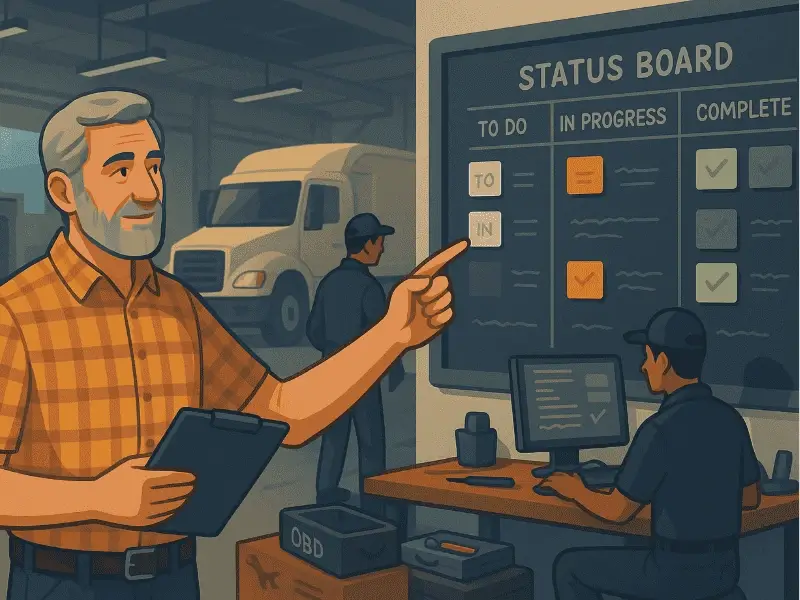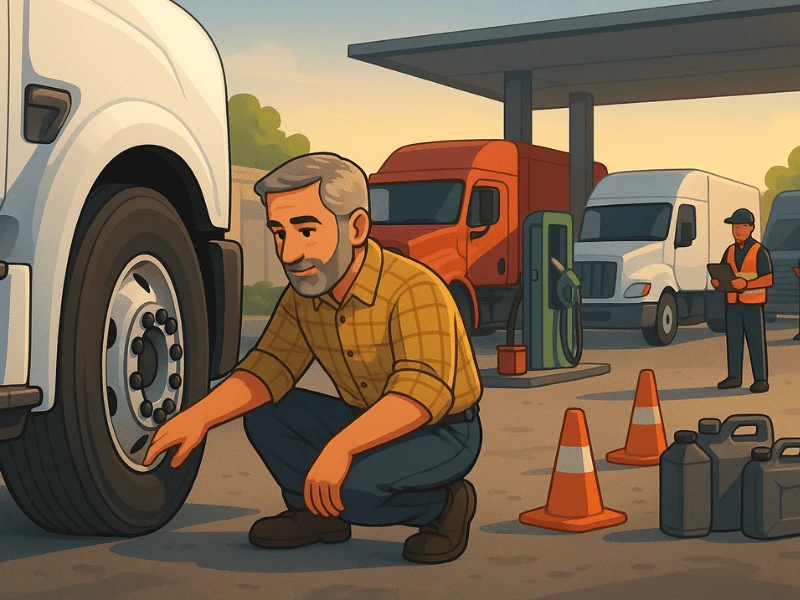Key Takeaways
- Plan your business: Define your niche, target market, and create a detailed trucking business plan.
- Register legally: Choose a business structure, name, and get your EIN, licenses, and permits.
- Get trucks & insurance: Buy or lease vehicles and secure liability and cargo coverage.
- Set up operations: Open a bank account, file compliance forms, and use fleet management tools.
- Find loads & grow: Use load boards, brokers, and digital fleet management (like Simply Fleet) to expand efficiently.
The trucking industry keeps North America’s economy moving, literally. From raw materials to retail goods, trucks transport nearly everything we use daily. If you’ve ever thought about joining this high-demand industry, you’re not alone. But the question most new entrepreneurs ask is: What do I need to start a trucking business?
Whether you’re planning to start small with one truck or scale into a full-fledged fleet, this guide walks you through everything you need to know, from business registration to compliance, funding, and finding loads.
Why Start a Trucking Business?
Trucking is the backbone of trade and logistics in the U.S. and Canada. According to industry estimates, trucks move nearly 70% of all freight across the continent. That means consistent demand, reliable income potential, and a wide range of niches, from food transport to long-haul freight.
If you’re wondering how to start your own trucking company or how to start a trucking business with one truck, the good news is that the barriers to entry are manageable as long as you plan carefully and follow the right steps.
Steps to to Start a Trucking Business
Step 1: Plan Out Your Trucking Business
Before you buy a truck or apply for a license, spend time building a solid plan. This will serve as your roadmap for everything ahead, operations, expenses, target customers, and profitability.
Define Your Niche
Choosing a niche helps you focus your operations and market more effectively. Ask yourself:
- What types of goods will you haul (general freight, refrigerated food, fuel, or raw materials)?
- Do you prefer local short-haul trips or long-haul routes across provinces or states?
- Which industries in your region (agriculture, oil and gas, retail) offer consistent shipping demand?
A focused niche not only helps you find reliable clients but also lets you specialize your fleet and pricing strategy.
Create a Business Plan
A trucking business plan outlines your goals, market positioning, funding needs, and revenue model. Include:
- Market analysis and competition overview
- Startup costs and funding strategy
- Fleet structure (owner-operator or employed drivers)
- Projected cash flow and profit forecasts
If you plan to approach banks or investors, your business plan will also be a crucial document for loan approvals.
Choose a Business Structure
Pick the structure that fits your needs:
- Sole Proprietorship: Simple to set up, but the owner is personally liable for all debts.
- Partnership: Shared ownership and responsibilities between two or more people.
- Corporation or LLC: Provides liability protection and better access to financing, but involves more paperwork.
Each option has tax and legal implications, so consulting a business advisor or accountant is highly recommended.
Step 2: Choose and Register Your Business Name
Your trucking company name is part of your brand identity, it should be professional, unique, and easy to remember. Once you’ve picked one, check that it’s not already in use by searching your national and state databases.
After that, register your business name and get your business number (BN) or Employer Identification Number (EIN). This number identifies your company when you file taxes or apply for permits.
Step 3: Obtain the Right Licenses and Permits
This is one of the most crucial parts of starting your trucking company. Without the proper permits and registrations, your business can face heavy fines or shutdowns.
Federal and Provincial/State Requirements
You’ll need to apply for several key identifiers and certifications, including:
- USDOT Number and Motor Carrier (MC) Number: Issued by the Federal Motor Carrier Safety Administration (FMCSA) in the U.S., allowing you to operate interstate.
- Business Number and CRA Account (for Canadian companies): Required for Goods and Services Tax (GST), fuel charge, and corporate income tax.
- IFTA (International Fuel Tax Agreement): Simplifies fuel tax reporting for carriers operating across multiple U.S. states or Canadian provinces.
- IRP (International Registration Plan): Ensures proper vehicle registration across jurisdictions.
- Safety Fitness Certificate (National Safety Code in Canada): Confirms compliance with safety standards before operations begin.
Driver and Equipment Requirements
If you plan to drive your own truck, you’ll need a Commercial Driver’s License (CDL). The type of CDL you need depends on your vehicle weight and the type of goods you transport.
You must also comply with Hours of Service (HOS) rules and install Electronic Logging Devices (ELDs) to record driver hours. These tools improve compliance, safety, and efficiency and most modern fleet management systems now include them.
Step 4: Get Trucking Insurance

Trucking insurance is a lifeline for your business. Common types include:
- General Liability Insurance: Covers damage caused by your operations (approx. $500–$800 per year).
- Primary Liability Insurance: Covers accidents and injuries caused by your truck ($5,000–$12,000 per year).
- Cargo Insurance: Protects the goods you transport ($15,000–$32,000 depending on the vehicle and cargo).
- Physical Damage Coverage: Covers truck and trailer repair or replacement costs.
Insurance costs vary based on your driving history, routes, and the type of freight you carry.
Step 5: Buy or Lease Your Trucks
One of the biggest questions new owners ask is how to start a trucking business with one truck. Starting small is often the best approach, it lets you build experience and manage finances more easily.
You can:
- Buy: Full ownership and long-term equity but high upfront costs ($80,000–$200,000).
- Lease: Lower monthly payments ($800–$2,500/month) but no ownership. Lease-purchase options combine both benefits over time.
When selecting your truck, consider:
- Payload capacity and hauling distance
- Fuel efficiency
- New vs. used truck lifespan and maintenance costs
Fleet management software can help monitor your truck’s performance, maintenance schedules, and fuel usage from day one, essential for long-term profitability.
Step 6: Set Up Operations and Compliance
To legally operate and grow your trucking business, you’ll need a few more operational steps:
- File a BOC-3 form: Designates a process agent to receive legal documents on your behalf.
- Complete Unified Carrier Registration (UCR): Annual compliance requirement for interstate carriers.
- Open a Business Bank Account: Keeps your business and personal finances separate.
- Set Up Accounting Software: Tracks expenses, payments, and tax filings.
If you’re wondering how to run a trucking company from home, it’s possible with the right setup. Many small trucking businesses use digital fleet management tools to handle dispatch, route tracking, and compliance remotely.
Step 7: Hire Drivers and Staff
As your company grows, you’ll need a reliable team. Essential roles include:
- Truck drivers
- Dispatcher
- Bookkeeper or accountant
- HR or recruiting staff
- Operations and compliance manager
To attract and retain good drivers, provide competitive pay, benefits, and clear communication channels. Fleet management platforms can also simplify driver scheduling and performance tracking.
Download a Free Truck Maintenance Checklist
Step 8: Secure Funding
Starting a trucking business can cost anywhere from $10,000 to $200,000, depending on how many trucks you operate and your equipment needs.
If you need capital to get started:
- Apply for Small Business Administration (SBA) loans — ideal for lower interest rates.
- Consider equipment financing or leasing to spread truck costs over time.
- Explore government grants or incentives for Canadian-based businesses.
Having a solid business plan and good credit history improves your chances of approval.
Step 9: Find Loads and Build Relationships
Once your trucks are ready, it’s time to find clients. Use:
- Load Boards (like DAT or Truckstop) to match with shippers.
- Freight Brokers to find steady routes and negotiate rates.
- Direct Contracts with manufacturers or retailers to maximize profits.
Building strong relationships with shippers ensures consistent work and helps you scale faster.
Step 10: Use Fleet Management Technology
Modern fleet management systems help you:
- Track vehicles and routes in real time.
- Manage driver hours and ELD compliance.
- Monitor fuel efficiency and maintenance.
- Streamline communication with drivers and dispatchers.
By digitizing your operations, you can reduce downtime, control costs, and scale more efficiently.
Final Thoughts
Starting a trucking company is both challenging and rewarding. From getting your CDL to handling permits and compliance, each step brings you closer to becoming an independent business owner in one of North America’s most vital industries.
With the right strategy and tools, your first truck can pave the way for an entire fleet. Ready to launch your trucking company the smart way? Simplify everything from vehicle maintenance to compliance with Simply Fleet, the all-in-one fleet management platform trusted by growing trucking businesses. Track expenses, monitor routes, and manage driver performance effortlessly. Start your free trial today and take control of your trucking operations with confidence



.png)








.png)


.png)

.webp)
.webp)




.png)



